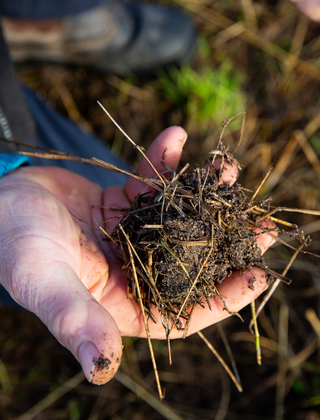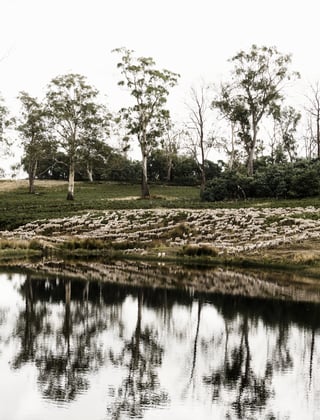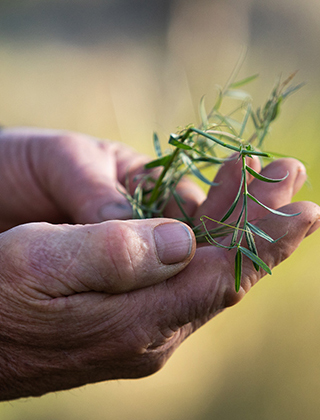Biodiversity
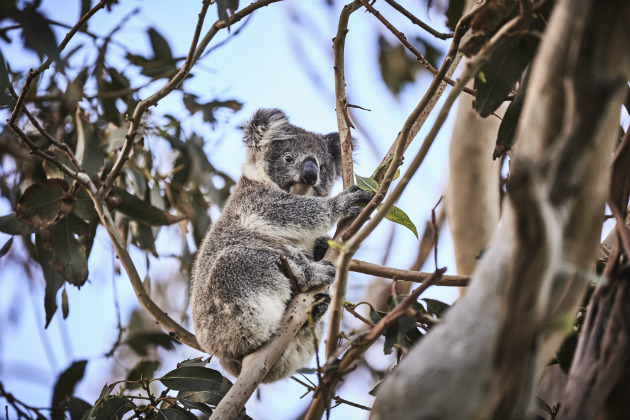
Many woolgrowers have profitable enterprises characterised by high levels of native biodiversity by investing in a wide variety of management practices to enhance farm profitability as well as native biodiversity.
Biodiversity is a subject which has come to the fore of the global sustainability agenda.
It is a topic that brands are increasingly looking at when considering sourcing raw materials for their products. As well as regulatory pressures on brands, consumers are also increasingly looking for brands to have biodiversity measures in place. Faced with these two pressures, and often with their own desire to do better, brands are implementing sourcing strategies that take biodiversity into account.
Natural resource management, including the encouragement of on-farm biodiversity, are of course not new to Australian woolgrowers. For generations, Australian woolgrowers have managed their rural businesses effectively while also undertaking initiatives to protect the natural environment.
Many woolgrowers have profitable enterprises characterised by high levels of native biodiversity. These have been achieved by investing in a wide variety of management practices to enhance farm profitability as well as native biodiversity. Management practices have included:
- grazing management of natural pasture including rotational and phase grazing
- tree management such as protecting and enhancing woody vegetation, developing windbreaks and wildlife corridors, plantation forestry and agroforestry
- river and water management including protecting riparian zones and farm dams and creating and protecting wetlands.
In an AWI survey (May 2020) of more than 1,000 woolgrowers, 89% of growers reported using more than one practice to encourage soil health. Specifically, 83% preserve groundcover, 74% undertake soil tests, 72% undertake rotation grazing, 65% no-till cropping and 50% sow deep rooted perennials.
AWI has been working, often collaboratively with industry groups, on projects to set up the industry for success into the future. For example:
Farming for the Future
This is a national research program, in which AWI participates, that aims to provide the evidence and practical support for farmers to incorporate natural capital as part of a profitable farming business, with specific insights on biodiversity. See www.farmingforthefuture.org.au
In July 2023, the Farming for the Future program issued five case studies of Australian woolgrowers:
In July 2023, The Farming for the Future program, in which AWI participates, issued five case studies of Australian woolgrowers that are managing investment in their property’s natural capital in a way that maximises both business prosperity and environmental returns including biodiversity.
Jo and Greg Bear – Tiverton
Jo and Greg Bear are growing more than sheep on their northern Victorian floodplain farm, with an inland island between rivers on their property acting as a refuge for native animals.
John and Isabelle Atkinson – Maitland
John and Isabelle Atkinson’s farm in the Tasmanian Midlands contains extensive native remnants. Active management of the property for conservation ensures they will remain into the future – for everyone’s benefit.
Will and Nina Bennett – Ashby
Generations of purposeful management for a productive farm, with a focus on enhancing biodiversity and sustainability, has created a nature haven that Will and Nina Bennett in the Midlands of Tasmania love to live and work on.
Stuart Hutton - Fern Hill
For woolgrower Stuart Hutton on the Northern Tablelands of NSW, a careful revision to a grazing strategy – with a focus on simplicity, improving biodiversity, and soil health – has stood the test of time through droughts and flooding rains.
Angus and Lucy Maurice – Gillinghall
By using both conventional and regenerative farming practices side-by-side, Angus and Lucy Maurice in central west NSW operate a productive and profitable farm, while improving the health of their special woodland areas.
Carbon Storage Partnership
This is an MLA-led, multi-party initiative that aims to identify the most effective techniques for farmers to reduce greenhouse gas emissions, sequester carbon in soil and vegetation, and build biodiversity. See www.mla.com.au/carbon-storage
Sheep Sustainability Framework
This is an initiative by the Australian sheep and wool industry to demonstrate the industry’s sustainable practices, which includes a priority of encouraging biodiversity. See www.sheepsustainabilityframework.com.au
Natural Capital Accounting
An AWI-funded project used Natural Capital Accounting to objectively measure the environmental credentials, including biodiversity protection, of 11 Australian wool-growing properties. See www.wool.com/nca
Land, Water & Wool
This five-year program (2002-2007) was the Australian wool industry’s most significant R&D investment in natural resource management, which tackled topics including biodiversity. Its Native Vegetation and Biodiversity sub-program developed, tested and promoted options for integrating wool production and the protection, management and restoration of native vegetation and its associated biodiversity.
A range of case studies, reports and other information from the Land, Water & Wool program is available below:
Case Studies and testimonials
Testimonials from woolgrowers who use natural resource management practises.
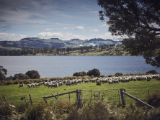
This publication profiles how 10 woolgrowers in south-eastern Australia are managing their native vegetation and biodiversity for productivity, amenity and conservation. While profitability is an important aspect of the way the case study growers run their farm businesses, it is not the only consideration leading to an investment of time and resources into improving their native vegetation.
Mary and Richard started using planned grazing (high-density, short-duration grazing with long recovery periods) in March 2000 as part of a trial of the Holistic Management approach promoted by Allan Savory.
Their land management aims include encouraging a largely self-sustaining, dense, native and naturalised perennial pasture with tree and shrub regeneration; and building soil by increasing organic matter.
Read more: Testimonials: Richard and Mary Maclean - Woodville East
Tony and Janet’s aim is to conduct a profitable wool enterprise whilst caring for and improving their native environment for the future. “We appreciate our natural resources and want to add to and improve them,” says Tony.
‘Wilson’s Creek’ wool averages 17.4 micron and is grown for the Italian spinners as well as Asian markets.
They aim for maximum profit through concentrating on the key profit drivers for superfine wool: a healthy animal, yielding profitable returns of fine wool from fertile, natural and introduced pastures.
Read more: Testimonials: Tony and Janet Gall - Wilson's Creek
The McKemeys have progressively adopted high-intensity, short-duration (‘cell’) grazing since 1991.
Dan says, "We're trying to change our focus from DSEs per acre to groundcover and livestock condition." "The goal is to maintain 100 per cent groundcover, so mob size, number and the speed of the rotation are adjusted to ensure pastures have sufficient rest.”
“I am leaning more to rotation of some stock at different times of the year,” explained Rob. “I can see better pasture utilisation and production in rotationally-grazed pastures. The stock are regularly going on to fresher, greener feed with less dead, indigestible matter; it encourages the better grasses which are not flogged down as much; the pastures are producing more feed and the stock are healthier with less worms.”
The Edmonds have revegetated 15% of ‘Ponds Creek’ and intend to increase this to 20-25% as part of their farm re-development plan. They have established 34 revegetation sites, planted more than 20 000 seedlings and direct seeded 50 km of trees and shrubs.
Read more: Testimonials: Gordon and Jan Edmonds - Ponds Creek
Michele and Graeme are passionate about their property’s native vegetation and its natural values. “It’s basically all native species providing the feed, shelter and shade,” says Graeme. “We need the native species of flora and fauna to run our grazing activities, so we try to work in harmony with nature to be sustainable well into the future.”
Read more: Testimonials: Michele and Graeme Blackman - Pint Pot
Their aim has been to develop the pastures and lift the productivity of ‘Blaxland’ to generate sufficient income for their family, repair environmental damage, develop a more sustainable farm ecosystem and enhance the property’s natural values. Like many woolgrowers, they want to “leave the farm in a more sustainable state than when we took over.”
Read more: Testimonials: James and Caroline Street - Blaxland
Tim and Karen believe in the importance to their business of a healthy natural resource base and of the native vegetation across ‘Lana’. According to Tim: “Native vegetation is 100 per cent important—‘Lana’ is a rangeland. We manage for biodiversity because it gives us better balance – more is good. There are lots of indicators. Our groundcover has improved. “The increase in abundance and diversity of native perennial grasses, in particular cool-season species, has given us more even feed production through the year. Clean water in the rivers and dams is valuable for stock, and we have a diversity of birds for pest control.”
Read more: Wool production and biodiversity at Lana
Wool production and biodiversity: Tim and Karen Wright
The most dramatic changes to occur at ‘The Hill’ in Jon’s lifetime were pasture improvement and New England dieback. After the worst of the dieback was over, Jon and Vicki pioneered a tree planting movement that continues today. Jon and Vicki have planted about 400,000 trees since 1979, mostly on ‘The Hill’, which has brought tree cover up to almost 20 per cent of the property.
“We want as much diversity as we can get,” says Jon. “To reduce tree loss, we want species with good survival and that provide a habitat for a diverse range of insects and birds in order to beat the beetles and their defoliation.”
Read more: Wool production and biodiversity The Hill
Wool production and biodiversity: Jon and Vicki Taylor
In a few short years, Rob and Annabel have transformed ‘Nant Lodge’ into an award-winning farm. Many people talk about trying to balance production with natural resource management (NRM), or about production versus conservation. For Rob and Annabel, however, NRM and productivity are inextricably linked because production depends on the resource base. “You can’t have one without the other,” says Rob. “Our principal environmental aim is to maintain groundcover and achieve productive outcomes. Biodiversity is one indicator of the health of our resource base, and its intrinsic value is the combined production, resilience and stability that it gives our farm ecosystem,” he says.
Read more: Wool production and biodiversity: Rob and Annabel Dulhunty
Richard and Jenny Weatherly have a life long commitment to develop a highly productive, sustainable farming system on their property ‘Connewarran’ located near Mortlake in Western Victoria.
Key components of Richard and Jenny’s vision have been to invest simultaneously in:
- fertility: all tested paddocks currently showing 15-21 Olsen P
- paddock size: there are now 60 paddocks on 1680 ha
- protection of wetlands: over 50 ha now managed as wetlands at 15 locations
- establishment of shelter belts and plantations: over 30 km established
- pasture productivity: 96% of the grazed area on the property has now been sown to improved pasture
Read more: Woolgrowers and bushland biodiversity in high rainfall areas
Tools and Resources
In collaboration with woolgrowers, industry bodies and government departments, we have developed extensive resources and tools for woolgrowers to use to support their natural resource management practises.
Native pastures are a valuable resource on many wool growing properties. Good grazing management and careful use of fertiliser can improve the productivity of these pastures while maintaining a high level of native species cover. Learning to identify the native species present and monitoring the effectiveness of management changes are key factors in developing productive and profitable native pastures.
The below tools and resources have been developed to help woolgrowers maintain and regenerate their native pasture resource.
- Productive native pastures in the high and medium rainfall zones
- Revealing the secrets for profitable, productive native pastures in the Mid-North
- Managing Tasmanian native pastures
- Managing grazing on native pastures in Tasmania
- Grazing native pastures in Tasmania - kangaroo grass
- Grazing native pastures in Tasmania - grassy weeds
- Grazing native pastures in Tasmania - forage
- Grazing native pastures in Tasmania - wallaby grass
- Pastures on New England wool properties
- Making more from your native pastures
- What do native vegetation, quality wool and health profits have in common?
Having more shelter trees on a property can contribute to improved profits and a better working environment. Shelterbelts provide many benefits including protection for livestock from harsh weather.
Fencing and managing native vegetation has extensive benefits including:
- shelter for lambing and shornies
- out of season feed
- farm appearance and land value
- erosion and salinity management
- drought fodder
The following resources have been created to inform woolgrowers of the practises they can adopt.
- Extension note 3: Using natural regeneration to establish shelter on wool properties
- Barking up the right tree
- Woolgrowers and bushland biodiversity in high rainfall areas
- Woolgrowers integrating paddock and catchment planning
- Productive resource management
- Extension note 1: Farm business, wool production and biodiversity
- Extension note 2: How can managing hill country be more profitable?
During the Land, Water & Wool Northern Tablelands Project (NSW), three Case Study farms—‘The Hill’, ‘Lana’ and ‘Nant Lodge’—were selected to demonstrate three quite different examples of profitable, biodiverse wool production. The owner-managers of all three properties recognised the value of biodiversity to their commercial success. However, the properties differed markedly in area, soil type, length of family ownership, intensity of development, grazing management and tree cover.
In order to assess biodiversity values, vertebrate fauna surveys were conducted in the summer of 2002-03. The aim was to establish the range and diversity of species on each property.
The surveys show that profitable wool production is compatible with the conservation of a wide range of vertebrate fauna.
Read more:
Regardless of the system used, it is possible to generate both profits and biodiversity benefits with a pro-active approach to managing the entire farming system.
Various practices to enhance biodiversity, with associated production benefits included:
- Establishing shelterbelts
- Increasing groundcover
- Regenerating native timber
- Conserving areas of native bush
- Fencing off creeks and dams
- Managing grazing
- Reducing runoff and erosion
- Lowering chemical use
- Retaining native pastures
The following resources detail the economic costs and benefits of managing biodiversity on farm.
- Economics and the environment: not mutually exclusive!
- Biodiversity and wool production - answers to the 10 big questions
- How to lift wool profits and improve biodiversity
- Farm business, wool production and biodiversity
- Integrating biodiversity conservation into sustainable grazing systems
- Integrating paddock and catchment planning
- The impact of grazing management on native grasses of non-arable pastures in the Mid-North of South Australia
- Profitable wool production - Victoria
- Our reputation for quality wool in the Midlands of Tasmania rides on the sheep's back - and on the health of our native vegetation
- A quick guide to the case study and testimonial farms
- How woolgrowers manage native vegetation and biodiversity on New England wool properties
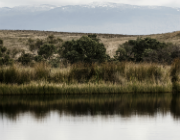
Natural Resource Management Tool
Quickchecks is an NRM Monitoring tool to assist woolgrowers to better understand the health of their land in order to manage it for their family’s long-term wealth and to pass it on in better condition. The manual contains six NRM modules that can be selected for monitoring grazing paddocks, soil health, woody vegetation, watercourse areas, birds and paddock production.






